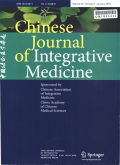- 钛学术文献服务平台 \
- 学术期刊 \
- 医药卫生期刊 \
- 中国医学期刊 \
- 中国结合医学杂志(英文版)期刊 \
Antioxidant and Antiapoptotic Polyphenols from Green Tea Extract Ameliorate CCl4-Induced Acute Liver Injury in Mice
Antioxidant and Antiapoptotic Polyphenols from Green Tea Extract Ameliorate CCl4-Induced Acute Liver Injury in Mice
基本信息来源于合作网站,原文需代理用户跳转至来源网站获取
摘要:
Objective:To investigate the phenolic composition,antioxidant properties,and hepatoprotective mechanisms of poiyphenols from green tea extract (GTP) in carbon tetrachloride (CCl4)-induced acute liver injury mouse model.Methods:High-performance liquid chromatography was used to analyze the chemical composition of the extract.Antioxidant activity of GTP was assessed by O2-,OH·,DPPH·,and ferric-reducing antioxidant power (FRAP) assay in vitro.Sixty Kunming mice were divided into 6 groups including control,model,low-,medium-,and high-doses GTP (200,400,800 mg/kg) and vitamin E (250 mg/kg) groups,10 in each group.GTP and vitamin E were administered at a level of abovementioned doses twice per day for 7 days prior to exposure to a single injection of CCl4.Hepatoprotective effects of GTP were evaluated in a CCl4-induced mouse model of acute liver injury,using commercial enzyme linked immunosorbent assay kits,histopathological observation,terminal deoxynucleotidyl transferase-mediated dUTPNick-end labeling (TUNEL) assay and Western blot.Results:GTP contained 98.56 μg gallic acid equivalents per milligram extract total polyphenols,including epicatechingallate,epigallocatechin gallate,epicatechin,and epigallocatechin.Compared with the model group,low-,medium-,or high doses GTP significantly decreased serum levels of alanine aminotransferase and aspartate transaminase (P<0.01).Histopathological observation confirmed that pretreatment of GTP prevented swelling and necrosis in CCl4-exposed hepatocytes.Hepatoprotective effects of low-,medium-,and highdose GTP were associated with eliminating free radicals and improving superoxide dismutase,catalase,and glutathione peroxidase activity in the liver.Additionally,low-,medium-,and high-dose GTP decreased cell apoptosis in the CCl4-exposed liver (P<0.01).Phosphorylated nuclear factor kappa-B (NF-κ B),p53,Bcl-2 associated x protein/B-cell lymphoma/leukemia-2 gene,cytochrome C,and cleaved caspase-3 levels were downregulated compared with the model group (P<0.01).Conclusion:GTP achieves hepatoprotective effects by improving hepatic antioxidant status and preventing cell apoptosis through caspase-3-dependent signaling pathways.

推荐文章
CCl_4低温氯化人造金红石制备TiCl_4
四氯化钛
四氯化碳
Fe掺杂人造金红石
低温氯化
急性脑梗死病人血清 CXCL1、CCL4 表达 及其与预后的关系
急性脑梗死
CXC趋化因子配体1
趋化因子配体4
预后
Ar/CCl4联合净化对2219铝合金铸锭组织与力学性能的影响
2219铝合金
精炼
氢含量
CCl4
Ar/CCl4
联合净化
力学性能
内容分析
关键词云
关键词热度
相关文献总数
(/次)
(/年)
文献信息
| 篇名 | Antioxidant and Antiapoptotic Polyphenols from Green Tea Extract Ameliorate CCl4-Induced Acute Liver Injury in Mice | ||
| 来源期刊 | 中国结合医学杂志(英文版) | 学科 | |
| 关键词 | |||
| 年,卷(期) | 2020,(10) | 所属期刊栏目 | Original Articles |
| 研究方向 | 页码范围 | 736-744 | |
| 页数 | 9页 | 分类号 | |
| 字数 | 语种 | 英文 | |
| DOI | 10.1007/s11655-019-3043-5 | ||
五维指标
引文网络
引文网络
二级参考文献 (32)
共引文献 (8)
参考文献 (35)
节点文献
引证文献 (0)
同被引文献 (0)
二级引证文献 (0)
1969(1)
- 参考文献(0)
- 二级参考文献(1)
1976(1)
- 参考文献(0)
- 二级参考文献(1)
1988(1)
- 参考文献(0)
- 二级参考文献(1)
1989(1)
- 参考文献(0)
- 二级参考文献(1)
1997(2)
- 参考文献(1)
- 二级参考文献(1)
1998(6)
- 参考文献(1)
- 二级参考文献(5)
1999(1)
- 参考文献(0)
- 二级参考文献(1)
2000(2)
- 参考文献(1)
- 二级参考文献(1)
2001(3)
- 参考文献(0)
- 二级参考文献(3)
2002(2)
- 参考文献(0)
- 二级参考文献(2)
2003(6)
- 参考文献(1)
- 二级参考文献(5)
2005(2)
- 参考文献(1)
- 二级参考文献(1)
2008(1)
- 参考文献(0)
- 二级参考文献(1)
2009(4)
- 参考文献(2)
- 二级参考文献(2)
2010(3)
- 参考文献(1)
- 二级参考文献(2)
2011(2)
- 参考文献(1)
- 二级参考文献(1)
2013(4)
- 参考文献(4)
- 二级参考文献(0)
2014(4)
- 参考文献(4)
- 二级参考文献(0)
2015(5)
- 参考文献(3)
- 二级参考文献(2)
2016(9)
- 参考文献(8)
- 二级参考文献(1)
2017(7)
- 参考文献(7)
- 二级参考文献(0)
2020(0)
- 参考文献(0)
- 二级参考文献(0)
- 引证文献(0)
- 二级引证文献(0)
引文网络交叉学科
相关学者/机构
期刊影响力
中国结合医学杂志(英文版)
主办单位:
中国中西医结合学会
中国中医研究院
出版周期:
月刊
ISSN:
1672-0415
CN:
11-4928/R
开本:
大16开
出版地:
北京西苑操场1号
邮发代号:
82-825
创刊时间:
1995
语种:
eng
出版文献量(篇)
2643
总下载数(次)
0
总被引数(次)
8415
期刊文献
相关文献
推荐文献
- 期刊分类
- 期刊(年)
- 期刊(期)
- 期刊推荐
中国结合医学杂志(英文版)2022
中国结合医学杂志(英文版)2021
中国结合医学杂志(英文版)2020
中国结合医学杂志(英文版)2019
中国结合医学杂志(英文版)2018
中国结合医学杂志(英文版)2017
中国结合医学杂志(英文版)2016
中国结合医学杂志(英文版)2015
中国结合医学杂志(英文版)2014
中国结合医学杂志(英文版)2013
中国结合医学杂志(英文版)2012
中国结合医学杂志(英文版)2011
中国结合医学杂志(英文版)2010
中国结合医学杂志(英文版)2009
中国结合医学杂志(英文版)2008
中国结合医学杂志(英文版)2007
中国结合医学杂志(英文版)2006
中国结合医学杂志(英文版)2005
中国结合医学杂志(英文版)2004
中国结合医学杂志(英文版)2003
中国结合医学杂志(英文版)2002
中国结合医学杂志(英文版)2001
中国结合医学杂志(英文版)2000
中国结合医学杂志(英文版)1999
中国结合医学杂志(英文版)1998
中国结合医学杂志(英文版)2020年第9期
中国结合医学杂志(英文版)2020年第8期
中国结合医学杂志(英文版)2020年第7期
中国结合医学杂志(英文版)2020年第6期
中国结合医学杂志(英文版)2020年第5期
中国结合医学杂志(英文版)2020年第4期
中国结合医学杂志(英文版)2020年第3期
中国结合医学杂志(英文版)2020年第2期
中国结合医学杂志(英文版)2020年第12期
中国结合医学杂志(英文版)2020年第11期
中国结合医学杂志(英文版)2020年第10期
中国结合医学杂志(英文版)2020年第1期

 免费查重
免费查重










